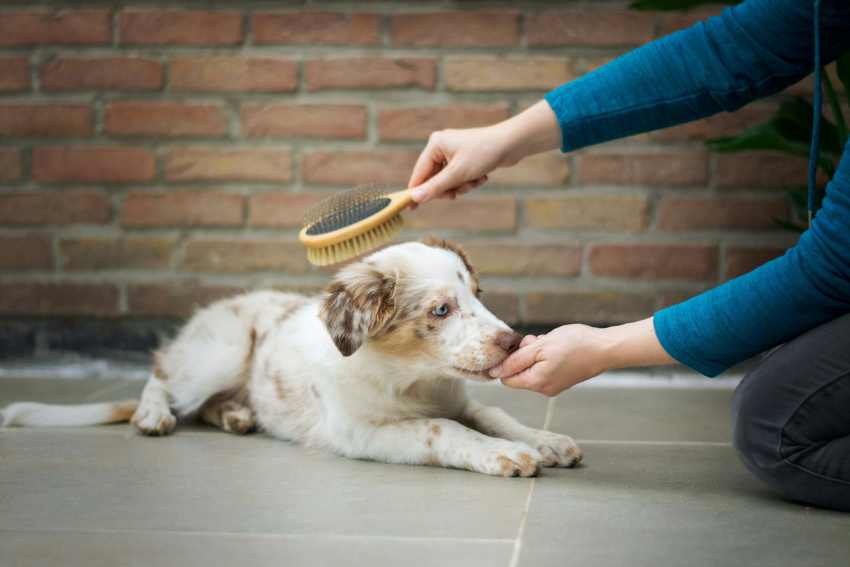Can old dogs learn new tricks? We’ve all heard the saying, “You can’t teach an old dog new tricks.” But is there any truth to this age-old adage?
As a dog owner or enthusiast, you might have wondered about the learning capacity of older dogs and at what point in their lives they stop picking up new skills.
In this comprehensive guide, we’ll explore the science behind canine learning, debunk myths surrounding older dogs, and shed light on when learning capabilities might plateau in our beloved furry companions.

Understanding Canine Learning:
Before diving into the topic of old dogs and new tricks, it’s crucial to understand how dogs learn. Canine learning primarily occurs through a process known as conditioning, which involves associating behaviors with consequences.
This can be further broken down into classical conditioning, (more on this below) where a dog learns to associate one stimulus with another, and operant conditioning, where behaviors are influenced by their consequences.
Dogs are incredibly adaptable and capable of learning throughout their lives. From basic obedience commands to complex tricks, their capacity for learning is not solely determined by age but also by factors such as breed, individual temperament, health, and previous experiences.
Debunking the Myth:
Contrary to popular belief, old dogs can indeed learn new tricks. While it’s true that puppies tend to learn more quickly due to their heightened curiosity and energy levels, older dogs are by no means incapable of learning.
In fact, many older dogs thrive in environments where they are continually challenged and engaged.
The key lies in the approach to training. Patience, consistency, and positive reinforcement are essential when teaching new behaviors to older dogs.
By breaking down tasks into smaller, manageable steps and rewarding progress, older dogs can surprise their owners with their ability to learn and adapt.
Factors Affecting Learning in Older Dogs:
While older dogs can continue to learn, it’s essential to consider certain factors that may affect their learning capabilities:
- Health: Age-related health issues such as arthritis or cognitive decline can impact a dog’s learning ability. Tailoring training methods to accommodate any physical or mental limitations is crucial.
- Previous Training: Dogs with a history of training may find it easier to learn new tricks, as they are already familiar with the process of learning and responding to commands.
- Environment: A stimulating and enriching environment can encourage learning in older dogs. Interactive toys, puzzles, and regular mental stimulation can help keep their minds sharp and receptive to new information.
At What Point Do Dogs Stop Learning?:
The notion that dogs reach a certain age where they stop learning is a misconception. While it’s true that older dogs may take longer to pick up new skills compared to their younger counterparts, there isn’t a specific age at which learning suddenly halts.
Instead, learning in dogs tends to plateau when they become less physically and mentally active due to age-related changes. However, with proper care, enrichment, and training, older dogs can continue to learn and adapt well into their senior years.
Conclusion: Can old dogs learn new tricks
In conclusion, the idea that old dogs can’t learn new tricks is a myth that doesn’t hold up to scientific scrutiny. Dogs of all ages, including seniors, have the capacity to learn and adapt, given the right approach to training and environmental factors.
By understanding the principles of canine learning and debunking common misconceptions, dog owners can provide their furry companions with enriching experiences that promote lifelong learning and mental stimulation.
So, the next time you hear someone say, “You can’t teach an old dog new tricks,” you can confidently debunk the myth and showcase the incredible learning potential of dogs at any stage of life. You might be surprised by what your old dog can accomplish with patience, consistency, and creativity!

Unlocking Canine Learning: Harnessing the Power of Classical Conditioning
Classical conditioning, also known as Pavlovian conditioning, is a fundamental concept in the field of psychology that plays a significant role in understanding how animals, including dogs, learn. This type of learning involves associating a neutral stimulus with a meaningful stimulus to produce a newly learned response.
The process of classical conditioning was first described by Ivan Pavlov, a Russian physiologist, in the late 19th century. Pavlov conducted experiments with dogs to investigate their digestive processes, but he noticed something intriguing during his research: the dogs began to salivate not only when presented with food but also when they anticipated being fed.
This observation led Pavlov to explore the phenomenon of associative learning, which eventually became known as classical conditioning.
Here’s how classical conditioning works:
- Neutral Stimulus (NS): At the beginning of the conditioning process, a neutral stimulus, which does not naturally elicit a response, is presented to the subject. In Pavlov’s experiments, this neutral stimulus was the sound of a bell.
- Unconditioned Stimulus (US): The unconditioned stimulus is a stimulus that naturally triggers a response without prior learning. In Pavlov’s experiments, the unconditioned stimulus was the presentation of food, which naturally caused the dogs to salivate.
- Unconditioned Response (UR): The unconditioned response is the natural response that occurs in the absence of learning. In Pavlov’s experiments, the unconditioned response was the dogs’ salivation in response to the presentation of food.
- Conditioned Stimulus (CS): Through repeated pairings with the unconditioned stimulus, the neutral stimulus becomes associated with the unconditioned stimulus and eventually elicits a learned response on its own. The neutral stimulus is now referred to as the conditioned stimulus. In Pavlov’s experiments, the sound of the bell became the conditioned stimulus.
- Conditioned Response (CR): The conditioned response is the learned response that occurs when the conditioned stimulus is presented. It is similar to the unconditioned response but is now triggered by the conditioned stimulus. In Pavlov’s experiments, the dogs’ salivation in response to the sound of the bell, without the presence of food, became the conditioned response.
Classical conditioning demonstrates how animals, including dogs, can learn to associate neutral stimuli with meaningful stimuli, leading to the development of newly learned responses. This type of learning is pervasive in everyday life and plays a role in various training techniques used with dogs, such as associating a clicker sound with receiving a treat during clicker training.
Understanding classical conditioning is essential for dog trainers and owners alike, as it provides insights into how dogs learn and respond to different stimuli in their environment. By utilizing the principles of classical conditioning effectively, trainers can shape desired behaviors and modify unwanted behaviors in dogs through systematic training methods.
Related Topics:
The Ultimate Training Course for Dogs (& Their Owners)

I don’t expect much from my dogs, once they have grown out of peeing on the carpet stage. I am happy when they come when called, walk at heel, don’t pull on the leash, only bark when there is genuine danger and stay off my chair. All basic stuff.
I’d be thinking you’d be happy if your dog did the same. Right?
But does s/he?
Continue reading for the Ultimate Training Course for Dogs
Online Dog Training Courses: Master the Art of Dog Training from the Comfort of Your Home

The convenience of online courses means you can learn at your own pace and fit training sessions into your schedule, no matter how busy you are. Plus, with interactive videos, demonstrations, and instructional materials, you’ll have all the tools you need to succeed.
Continue reading: Online Dog Training Courses
The Power of Positive Reinforcement: Understanding the Basics of Positive Reinforcement

Many dog owners want the best training for their pups, but did you know that many puppy experts still overlook the power of positive reinforcement? Learn why this training method is so effective and the common mistakes even experts make.
Discover how rewarding good behavior, rather than punishing mistakes, builds trust and fosters a happy, well-behaved dog. Ready to find out what most puppy experts get wrong? Read on!
Continue reading: The Power of Positive Reinforcement.

